See Page 1 |
2 |
3 |
4 |
5 of the August 2022 homepage archives. Sunday the 7th
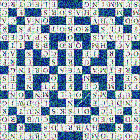 Here is your custom made
Science Themed Crossword Puzzle for August 7th, 2022. All RF Cafe crossword
puzzles are custom made by me, Kirt Blattenberger, and have only words and clues
related to RF, microwave, and mm-wave engineering, optics, mathematics, chemistry,
physics, and other technical subjects. As always, this crossword contains no names
of politicians, mountain ranges, exotic foods or plants, movie stars, or anything
of the sort unless it/he/she is related to this puzzle's technology theme (e.g.,
Reginald Denny or the Tunguska event in Siberia). The technically inclined cruciverbalists
amongst us will appreciate the effort. Enjoy! Here is your custom made
Science Themed Crossword Puzzle for August 7th, 2022. All RF Cafe crossword
puzzles are custom made by me, Kirt Blattenberger, and have only words and clues
related to RF, microwave, and mm-wave engineering, optics, mathematics, chemistry,
physics, and other technical subjects. As always, this crossword contains no names
of politicians, mountain ranges, exotic foods or plants, movie stars, or anything
of the sort unless it/he/she is related to this puzzle's technology theme (e.g.,
Reginald Denny or the Tunguska event in Siberia). The technically inclined cruciverbalists
amongst us will appreciate the effort. Enjoy!
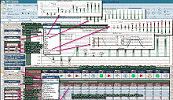 RF Cascade Workbook is the next phase in the evolution of
RF Cafe's long-running series, RF Cascade Workbook. Chances are you have
never used a spreadsheet quite like this (click here for screen capture). It is a full-featured RF system
cascade parameter and frequency planner that includes filters and mixers for a mere
$45. Built in MS Excel, using RF Cascade Workbook 2018 is a cinch
and the format is entirely customizable. It is significantly easier and faster than
using a multi-thousand dollar simulator when a high level system analysis is all
that is needed. An intro video takes you through the main features...
RF Cascade Workbook is the next phase in the evolution of
RF Cafe's long-running series, RF Cascade Workbook. Chances are you have
never used a spreadsheet quite like this (click here for screen capture). It is a full-featured RF system
cascade parameter and frequency planner that includes filters and mixers for a mere
$45. Built in MS Excel, using RF Cascade Workbook 2018 is a cinch
and the format is entirely customizable. It is significantly easier and faster than
using a multi-thousand dollar simulator when a high level system analysis is all
that is needed. An intro video takes you through the main features...
 RF Superstore launched in 2017, marking
the return of Murray Pasternack, founder of Pasternack Enterprises, to the RF and
microwave Industry. Pasternack fundamentally changed the way RF components were
sold. Partner Jason Wright manages day-to-day operations, while working closely
with Mr. Pasternack to develop RF Superstore into a world class RF and
microwave
component supplier. RF coaxial connectors & adapters, coaxial cable &
cable assemblies, surge protectors, attenuators. Items added daily. Free shipping
on orders over $25. We're leading the way again! RF Superstore launched in 2017, marking
the return of Murray Pasternack, founder of Pasternack Enterprises, to the RF and
microwave Industry. Pasternack fundamentally changed the way RF components were
sold. Partner Jason Wright manages day-to-day operations, while working closely
with Mr. Pasternack to develop RF Superstore into a world class RF and
microwave
component supplier. RF coaxial connectors & adapters, coaxial cable &
cable assemblies, surge protectors, attenuators. Items added daily. Free shipping
on orders over $25. We're leading the way again!
Friday the 5th
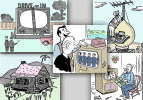 As I often do on Fridays, I searched through
my collection of vintage electronics magazines for some
tech-themed comics. This group of five appeared in the July 1952 issue of
Radio-Electronics. A couple of these were suggested by the magazine's readers,
and staff artists turn the ideas into drawings. The Standing Waves comics gets my
vote for the best of the lot for cleverness. Page 102's comic could be (almost)
a depiction of a contemporary in-home entertainment center, given the size of televisions
today. For some reason I'm not "getting" the gag in the page 113 comic, which features
a buxom woman with big hair doing a juggling act on TV... As I often do on Fridays, I searched through
my collection of vintage electronics magazines for some
tech-themed comics. This group of five appeared in the July 1952 issue of
Radio-Electronics. A couple of these were suggested by the magazine's readers,
and staff artists turn the ideas into drawings. The Standing Waves comics gets my
vote for the best of the lot for cleverness. Page 102's comic could be (almost)
a depiction of a contemporary in-home entertainment center, given the size of televisions
today. For some reason I'm not "getting" the gag in the page 113 comic, which features
a buxom woman with big hair doing a juggling act on TV...
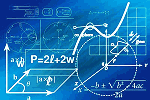 I have to admit to being drawn to this story
primarily due to the graphic. Although it does not appear on an RF website, there
is a Smith chart and reflection coefficient equations included. I also like the
striated blue motif. "Multivariable calculus, differential equations, linear algebra
- topics that many MIT students can ace without breaking a sweat - have consistently
stumped
machine learning models. The best models have only been able to answer elementary
or high school-level math questions, and they don't always find the correct solutions.
Now, a multidisciplinary team of researchers from MIT and elsewhere, led by Iddo
Drori, a lecturer in the MIT Department of Electrical Engineering and Computer Science
(EECS), has used a neural network model to solve university-level math problems
in a few seconds at a human level. The model also automatically explains solutions
and rapidly generates new problems in university math subjects. When the researchers
showed these machine-generated questions to university students, the students were
unable to tell..." I have to admit to being drawn to this story
primarily due to the graphic. Although it does not appear on an RF website, there
is a Smith chart and reflection coefficient equations included. I also like the
striated blue motif. "Multivariable calculus, differential equations, linear algebra
- topics that many MIT students can ace without breaking a sweat - have consistently
stumped
machine learning models. The best models have only been able to answer elementary
or high school-level math questions, and they don't always find the correct solutions.
Now, a multidisciplinary team of researchers from MIT and elsewhere, led by Iddo
Drori, a lecturer in the MIT Department of Electrical Engineering and Computer Science
(EECS), has used a neural network model to solve university-level math problems
in a few seconds at a human level. The model also automatically explains solutions
and rapidly generates new problems in university math subjects. When the researchers
showed these machine-generated questions to university students, the students were
unable to tell..."
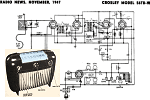 These are the schematics and parts list
for vintage
Crosley model 56TD-W vacuum tube radio, as it appeared in the November 1947
issue of Radio News magazine. I scan and post these for the benefit of hobbyists
and historians seeking such information. As time goes by, there is less and less
likelihood that records of these relics from yesteryear's archives will be made
available. As with all historical information, it takes someone with a personal
interest in preserving the memories in order to fulfill the mission, and I am glad
to be a small part of that cadre. Also, I found a short video (below) from someone
who did an excellent job restoring a Crosley Model 56TD Duette tabletop radio... These are the schematics and parts list
for vintage
Crosley model 56TD-W vacuum tube radio, as it appeared in the November 1947
issue of Radio News magazine. I scan and post these for the benefit of hobbyists
and historians seeking such information. As time goes by, there is less and less
likelihood that records of these relics from yesteryear's archives will be made
available. As with all historical information, it takes someone with a personal
interest in preserving the memories in order to fulfill the mission, and I am glad
to be a small part of that cadre. Also, I found a short video (below) from someone
who did an excellent job restoring a Crosley Model 56TD Duette tabletop radio...
 Atek
Midas, based in Istanbul, Turkey, is a technology company working on high-frequency
integrated circuit (RFIC/MMIC) products as its roadmap. Their main target markets
are satellite communication, telecommunications, test & measurement and aerospace &
defense. Atek Midas has been added to my collection of
Vendor pages in the categories of
RFIC/MMIC's, attenuators, power and low noise amplifiers, mixers, power dividers,
filters, RF front ends. Please check out their website to see if they can help you
with your project... Atek
Midas, based in Istanbul, Turkey, is a technology company working on high-frequency
integrated circuit (RFIC/MMIC) products as its roadmap. Their main target markets
are satellite communication, telecommunications, test & measurement and aerospace &
defense. Atek Midas has been added to my collection of
Vendor pages in the categories of
RFIC/MMIC's, attenuators, power and low noise amplifiers, mixers, power dividers,
filters, RF front ends. Please check out their website to see if they can help you
with your project...
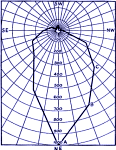 Antenna radiation (beam) patterns published
by manufacturers are obtained under ideal - or close to ideal - conditions with
a carefully prepared and calibrated open air test site (OATS) or an enclosed anechoic
chamber. Multipath, imperfect earth ground, obstacles both manmade and natural,
misshapen elements, poor VSWR, antenna orientation (in both azimuth and elevation)
are among the many factors which produce real-world operational results that do
not jive with a manufacturer's datasheet. Without employing some far field 3-dimensional
field strength scheme (see Drone-Based Field Measurement System™), there is no way
to obtain a complete picture of how your antenna performs in all directions. This
article presents a practical procedure for making measurements that will at least
collect useful data for specific orientations... Antenna radiation (beam) patterns published
by manufacturers are obtained under ideal - or close to ideal - conditions with
a carefully prepared and calibrated open air test site (OATS) or an enclosed anechoic
chamber. Multipath, imperfect earth ground, obstacles both manmade and natural,
misshapen elements, poor VSWR, antenna orientation (in both azimuth and elevation)
are among the many factors which produce real-world operational results that do
not jive with a manufacturer's datasheet. Without employing some far field 3-dimensional
field strength scheme (see Drone-Based Field Measurement System™), there is no way
to obtain a complete picture of how your antenna performs in all directions. This
article presents a practical procedure for making measurements that will at least
collect useful data for specific orientations...
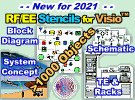 With more than 1000
custom-built stencils, this has got to be the most comprehensive set of
Visio Stencils available for RF, analog, and digital system and schematic
drawings! Every stencil symbol has been built to fit proportionally on the included
A-, B-, and C-size drawing page templates (or use your own page if preferred). Components
are provided for system block diagrams, conceptual drawings, schematics, test equipment,
racks (EIA 19", ETSI 21"), and more. Test equipment and racks are built at a 1:1
scale so that measurements can be made directly using Visio built-in dimensioning
objects. Page templates are provided with a preset scale (changeable) for a good
presentation that can incorporate all provided symbols... With more than 1000
custom-built stencils, this has got to be the most comprehensive set of
Visio Stencils available for RF, analog, and digital system and schematic
drawings! Every stencil symbol has been built to fit proportionally on the included
A-, B-, and C-size drawing page templates (or use your own page if preferred). Components
are provided for system block diagrams, conceptual drawings, schematics, test equipment,
racks (EIA 19", ETSI 21"), and more. Test equipment and racks are built at a 1:1
scale so that measurements can be made directly using Visio built-in dimensioning
objects. Page templates are provided with a preset scale (changeable) for a good
presentation that can incorporate all provided symbols...
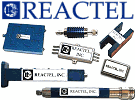
Reactel has become one of the industry leaders in the design and manufacture
of RF and microwave
filters, diplexers, and sub-assemblies. They offer the generally known tubular,
LC, cavity, and waveguide designs, as well as state of the art high performance
suspended substrate models. Through a continuous process of research and development,
they have established a full line of filters of filters of all types - lowpass,
highpass, bandpass, bandstop, diplexer, and more. Established in 1979. Please contact
Reactel today to see how they might help your project.
Thursday the 4th
 Prior to the invention of the
silicon-controlled rectifier (SCR), most semiconductor devices were only able
to handle powers in milliwatt range, with some reaching into the realm of a few
watts or tens of watts. Voltage handling got up to around 1 kV (and 500 A)
for diodes and 200 V for transistors. The higher power and voltage devices
were exceedingly expensive and were used primarily in special applications. When
this article appeared in a 1966 issue of Electronics World magazine and
the SCR had been introduced less than a decade earlier, the price of an SCR had
dropped from more than $300 to less that 50¢ apiece. Due to the construction of
the SCR, it is more robust and can handle high power switching applications (it
is generally not used as a signal amplifier). Unlike a triac, which can be controlled
with a signal to turn the device both on and off while voltage is present across
the anode and cathode, the SCR can only be used to switch off current... Prior to the invention of the
silicon-controlled rectifier (SCR), most semiconductor devices were only able
to handle powers in milliwatt range, with some reaching into the realm of a few
watts or tens of watts. Voltage handling got up to around 1 kV (and 500 A)
for diodes and 200 V for transistors. The higher power and voltage devices
were exceedingly expensive and were used primarily in special applications. When
this article appeared in a 1966 issue of Electronics World magazine and
the SCR had been introduced less than a decade earlier, the price of an SCR had
dropped from more than $300 to less that 50¢ apiece. Due to the construction of
the SCR, it is more robust and can handle high power switching applications (it
is generally not used as a signal amplifier). Unlike a triac, which can be controlled
with a signal to turn the device both on and off while voltage is present across
the anode and cathode, the SCR can only be used to switch off current...
 It's time to gather 'round for another story
about fictional radio service shop owner Mac McGregor and his trusted sidekick technician,
Barney. In this January 1954 Radio & Television News episode, an errantly
wired bypass capacitor on a chassis from one of the old AC/DC radio sets caused
Mac to get a 300-volt wakeup call when his hand brushed against it. After explaining
the situation to Barney and apprising him of the danger it poses to an owner who
unwittingly sticks his/her hand into the back of the cabinet, Mac lists a few other
common dangers to watch for. Radios that ran on either AC or DC power were very
common back in the early days because there were homes and businesses that had both
type systems wired in to the premises - in part due to the famous battle between
Thomas Edison's preferred DC electrical distribution system and Nikola Tesla's preferred
AC electrical distribution system. Another reason for DC compatibility was that
prior to the Rural Electrification Act of 1936, many homes not located in cities
and nearby suburbs had no electric service at all. Farm homes often ran on DC power
supplied by banks of lead-acid storage batteries, with wind- or water-powered generators
providing the charging current. Radios, aka "wireless sets," were powered by those
batteries. In order to accommodate both AC and DC supplies, radio designers conjured
up power supply circuits... It's time to gather 'round for another story
about fictional radio service shop owner Mac McGregor and his trusted sidekick technician,
Barney. In this January 1954 Radio & Television News episode, an errantly
wired bypass capacitor on a chassis from one of the old AC/DC radio sets caused
Mac to get a 300-volt wakeup call when his hand brushed against it. After explaining
the situation to Barney and apprising him of the danger it poses to an owner who
unwittingly sticks his/her hand into the back of the cabinet, Mac lists a few other
common dangers to watch for. Radios that ran on either AC or DC power were very
common back in the early days because there were homes and businesses that had both
type systems wired in to the premises - in part due to the famous battle between
Thomas Edison's preferred DC electrical distribution system and Nikola Tesla's preferred
AC electrical distribution system. Another reason for DC compatibility was that
prior to the Rural Electrification Act of 1936, many homes not located in cities
and nearby suburbs had no electric service at all. Farm homes often ran on DC power
supplied by banks of lead-acid storage batteries, with wind- or water-powered generators
providing the charging current. Radios, aka "wireless sets," were powered by those
batteries. In order to accommodate both AC and DC supplies, radio designers conjured
up power supply circuits...
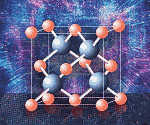 "Silicon is one of the most abundant elements
on Earth, and in its pure form the material has become the foundation of much of
modern technology, from solar cells to computer chips. But silicon's properties
as a semiconductor are far from ideal. For one thing, although silicon lets electrons
whizz through its structure easily, it is much less accommodating to "holes" - electrons'
positively charged counterparts - and harnessing both is important for some kinds
of chips. What's more, silicon is not very good at conducting heat, which is why
overheating issues and expensive cooling systems are common in computers. Now, a
team of researchers at MIT, the University of Houston, and other institutions has
carried out experiments showing that a material known as
cubic boron arsenide
overcomes both of these limitations. It provides high mobility to both electrons
and holes, and has excellent thermal conductivity..." "Silicon is one of the most abundant elements
on Earth, and in its pure form the material has become the foundation of much of
modern technology, from solar cells to computer chips. But silicon's properties
as a semiconductor are far from ideal. For one thing, although silicon lets electrons
whizz through its structure easily, it is much less accommodating to "holes" - electrons'
positively charged counterparts - and harnessing both is important for some kinds
of chips. What's more, silicon is not very good at conducting heat, which is why
overheating issues and expensive cooling systems are common in computers. Now, a
team of researchers at MIT, the University of Houston, and other institutions has
carried out experiments showing that a material known as
cubic boron arsenide
overcomes both of these limitations. It provides high mobility to both electrons
and holes, and has excellent thermal conductivity..."
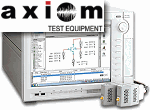 Axiom Test Equipment, Inc., an electronic
test equipment rental and sales company has published a new blog post entitled "Modular
Test Solution Speed Semiconductor Testing," explains how to pick the right module
when you need a solution with semiconductor testing. A well-designed mainframe that
operates according to plug-in modules can not only pack a great deal of measurement
power into a small space, but it can also be configured as needed by exchanging
modules. Modular semiconductor parameter testers are capable of top-line mainframe
accuracy along with the test speed and flexibility for high-volume production-line
device testing. Modular units provide a more "compressed" approach to executing
semiconductor parameter measurements. A modular unit consists... Axiom Test Equipment, Inc., an electronic
test equipment rental and sales company has published a new blog post entitled "Modular
Test Solution Speed Semiconductor Testing," explains how to pick the right module
when you need a solution with semiconductor testing. A well-designed mainframe that
operates according to plug-in modules can not only pack a great deal of measurement
power into a small space, but it can also be configured as needed by exchanging
modules. Modular semiconductor parameter testers are capable of top-line mainframe
accuracy along with the test speed and flexibility for high-volume production-line
device testing. Modular units provide a more "compressed" approach to executing
semiconductor parameter measurements. A modular unit consists...
 Achieving what we consider relatively simple
results with electronics indicators used to be cutting edge technology. This
6AL7-GT
Electron-Ray Indicator Tube by Ken-Rad (a division of General Electric) provided
a dual-channel electrofluorescent (i.e., cathode ray) display of relative signal
strength or tuning the new-fangled FM radio stations. It was promoted in this 1947
issue of Radio News magazine. The tube could also be used, of course, for
many other applications where signal strength from any measured process: fuel level,
voltage, temperature, stock price, phase angle, sound volume, speed, etc., needed
to be measured. Today, we have electrochemical indicators so cheap that they are
built into off-the-shelf batteries at Walmart... Achieving what we consider relatively simple
results with electronics indicators used to be cutting edge technology. This
6AL7-GT
Electron-Ray Indicator Tube by Ken-Rad (a division of General Electric) provided
a dual-channel electrofluorescent (i.e., cathode ray) display of relative signal
strength or tuning the new-fangled FM radio stations. It was promoted in this 1947
issue of Radio News magazine. The tube could also be used, of course, for
many other applications where signal strength from any measured process: fuel level,
voltage, temperature, stock price, phase angle, sound volume, speed, etc., needed
to be measured. Today, we have electrochemical indicators so cheap that they are
built into off-the-shelf batteries at Walmart...
 This assortment of custom-designed themes
by RF Cafe includes T-Shirts, Mouse Pads, Clocks, Tote Bags, Coffee Mugs and Steins,
Purses, Sweatshirts, and Baseball Caps. Choose from amazingly clever "We Are the World's
Matchmakers" Smith chart design or the "Engineer's Troubleshooting Flow Chart."
My "Matchmaker's" design has been ripped off by other people and used on their products,
so please be sure to purchase only official RF Cafe gear. My markup is only a paltry
50¢ per item - Cafe Press gets the rest of your purchase price. These would make
excellent gifts for husbands, wives, kids, significant others, and for handing out
at company events or as rewards for excellent service. It's a great way to help
support RF Cafe. Thanks... This assortment of custom-designed themes
by RF Cafe includes T-Shirts, Mouse Pads, Clocks, Tote Bags, Coffee Mugs and Steins,
Purses, Sweatshirts, and Baseball Caps. Choose from amazingly clever "We Are the World's
Matchmakers" Smith chart design or the "Engineer's Troubleshooting Flow Chart."
My "Matchmaker's" design has been ripped off by other people and used on their products,
so please be sure to purchase only official RF Cafe gear. My markup is only a paltry
50¢ per item - Cafe Press gets the rest of your purchase price. These would make
excellent gifts for husbands, wives, kids, significant others, and for handing out
at company events or as rewards for excellent service. It's a great way to help
support RF Cafe. Thanks...
 Berkeley Nucleonics Corporation (BNC) is
a leading manufacturer of precision electronic instrumentation for test, measurement,
and nuclear research. Founded in 1963, BNC initially developed custom pulse generators.
We became known for meeting the most stringent requirements for high precision and
stability, and for producing instruments of unsurpassed reliability and performance.
We continue to maintain a leadership position as a developer of custom pulse, signal,
light, and function generators. Our designs incorporate the latest innovations in
software and hardware engineering, surface mount production, and automated testing
procedures. Berkeley Nucleonics Corporation (BNC) is
a leading manufacturer of precision electronic instrumentation for test, measurement,
and nuclear research. Founded in 1963, BNC initially developed custom pulse generators.
We became known for meeting the most stringent requirements for high precision and
stability, and for producing instruments of unsurpassed reliability and performance.
We continue to maintain a leadership position as a developer of custom pulse, signal,
light, and function generators. Our designs incorporate the latest innovations in
software and hardware engineering, surface mount production, and automated testing
procedures.
Wednesday the 3rd
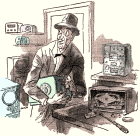 This is a pretty good
electronics-related detective story. Admittedly, it did not turn out the way
I expected, which is a good thing because the unexpected curve it threw me caused
me to like the adventure even more. The author is Guy Slaughter, but it could have
easily been one of John T. Frye's "Carl & Jerry" techno-adventures. I say
that because (without giving away the ending) the sleuthing "good guy" uses his
electronics communications savvy to solve the crime, the way Carl and Jerry are
famous for doing. The setting is the early 1950s when electronics repair shops were
commonplace and some customers did their best to swindle the proprietors out of
honestly earned money - and sometimes products. Guy Slaughter wrote earlier pieces
featuring Pedro for Radio-Electronics magazine... This is a pretty good
electronics-related detective story. Admittedly, it did not turn out the way
I expected, which is a good thing because the unexpected curve it threw me caused
me to like the adventure even more. The author is Guy Slaughter, but it could have
easily been one of John T. Frye's "Carl & Jerry" techno-adventures. I say
that because (without giving away the ending) the sleuthing "good guy" uses his
electronics communications savvy to solve the crime, the way Carl and Jerry are
famous for doing. The setting is the early 1950s when electronics repair shops were
commonplace and some customers did their best to swindle the proprietors out of
honestly earned money - and sometimes products. Guy Slaughter wrote earlier pieces
featuring Pedro for Radio-Electronics magazine...
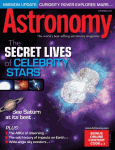 In the "Astro Letters" section of the September
2022 issue of Astronomy magazine,
a reader wrote to ask why Planck mass uses units of 10-5 grams, while
the other two Planck-scale constants (length at 10-33 cm and time
at 10-44 s) are many orders of magnitude smaller. Stan Odenwald
responded: "Using only the three natural constants - the speed of light (c=3x108 m/s),
Newton's gravitational constant (G=6.67x10-11 m3/kg s2),
and Planck's constant (h=6.6x10-34 m2 kg/s) - you
can create three 'fundamental scales': length = (hG/c3)½,
time = (hG/c5)½, and mass = (hG/c)½.
But these scales are experimentally inaccessible. Although the Planck mass appears
reachable (i.e., larger than the other quantities), it actually represents an energy
of 1019 gigaelectronvolts crammed into a Planck-scale volume, which cannot
be replaced by humans (yet). By comparison, the Large Hadron Collider at CERN achieves
only 104 GeV in a volume of space 1010 time larger then the
Planck scale." I'd like to be able to answer a question like that! In the "Astro Letters" section of the September
2022 issue of Astronomy magazine,
a reader wrote to ask why Planck mass uses units of 10-5 grams, while
the other two Planck-scale constants (length at 10-33 cm and time
at 10-44 s) are many orders of magnitude smaller. Stan Odenwald
responded: "Using only the three natural constants - the speed of light (c=3x108 m/s),
Newton's gravitational constant (G=6.67x10-11 m3/kg s2),
and Planck's constant (h=6.6x10-34 m2 kg/s) - you
can create three 'fundamental scales': length = (hG/c3)½,
time = (hG/c5)½, and mass = (hG/c)½.
But these scales are experimentally inaccessible. Although the Planck mass appears
reachable (i.e., larger than the other quantities), it actually represents an energy
of 1019 gigaelectronvolts crammed into a Planck-scale volume, which cannot
be replaced by humans (yet). By comparison, the Large Hadron Collider at CERN achieves
only 104 GeV in a volume of space 1010 time larger then the
Planck scale." I'd like to be able to answer a question like that!
 Except for a few notable examples such as
the incredibly life-like humanoid robots coming from Japan, the overwhelming majority
of
robots today are either educational tools, special function equipment for performing
highly precise tasks (surgical, exploratory, search & rescue), or part of high
volume production lines. Back in 1940 when this "Telecan" robot debuted and appeared
in National Radio News magazine, people though of robots almost exclusively
as autonomous devices that would some day make life easier for the human race...
or eventually conquer and subdue the human race into slavery. Constraining robots
to the relatively inefficient layout and proportions of homo sapiens, as engineers
have discovered, greatly limits their utility... Except for a few notable examples such as
the incredibly life-like humanoid robots coming from Japan, the overwhelming majority
of
robots today are either educational tools, special function equipment for performing
highly precise tasks (surgical, exploratory, search & rescue), or part of high
volume production lines. Back in 1940 when this "Telecan" robot debuted and appeared
in National Radio News magazine, people though of robots almost exclusively
as autonomous devices that would some day make life easier for the human race...
or eventually conquer and subdue the human race into slavery. Constraining robots
to the relatively inefficient layout and proportions of homo sapiens, as engineers
have discovered, greatly limits their utility...
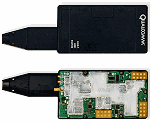 Maurizio
Di Paolo Emilio has an article on the EE|Times website entitled ,"Antenna
Design Considerations for 5G Applications," which discusses some of the issues
needed to be addressed for mobile hardware, namely multiple frequency bands and
increased bandwidth. He begins, "A 5G mobile device's antenna design needs specific
consideration to maintain performance. The entire performance is impacted by the
ground plane, the antenna positioning on the board, and other associated components.
The reliability needed by wireless devices is made possible by analyzing and making
corrections from the very beginning of design. In order for smartphones to function
well over a wider variety of RF frequency bands and support the transition to 5G
and other technologies, tuning the aperture of an antenna is crucial. To accommodate
expanding RF needs such as the usage of multiple input, multiple output (MIMO),
and carrier aggregation (CA) methods..." Maurizio
Di Paolo Emilio has an article on the EE|Times website entitled ,"Antenna
Design Considerations for 5G Applications," which discusses some of the issues
needed to be addressed for mobile hardware, namely multiple frequency bands and
increased bandwidth. He begins, "A 5G mobile device's antenna design needs specific
consideration to maintain performance. The entire performance is impacted by the
ground plane, the antenna positioning on the board, and other associated components.
The reliability needed by wireless devices is made possible by analyzing and making
corrections from the very beginning of design. In order for smartphones to function
well over a wider variety of RF frequency bands and support the transition to 5G
and other technologies, tuning the aperture of an antenna is crucial. To accommodate
expanding RF needs such as the usage of multiple input, multiple output (MIMO),
and carrier aggregation (CA) methods..."
 For many years I have scanned and posted
schematics & parts lists like this one featuring the
Emerson models 507, 509, 518, 522, 535 Chassis Model 120005. An image of the
page is included which, depending on the issue, might include a schematic, parts
list, and tuning and service information. If there is extensive text, I run OCR
on the scanned page and place it on the page to aid search engines. In this case,
the September 1947 edition of Radio News contained only the schematic and parts
list. A lot of these radios can be purchased on eBay. The Radio Museum and Radio
Attic websites have some additional information. In fact, the image to the left
is from a recent sale there. There are still many people who restore and service
these vintage radios, and often it can be difficult or impossible to find schematics
and/or tuning information. A running list of all data sheets posted thus far is
at the bottom of the page... For many years I have scanned and posted
schematics & parts lists like this one featuring the
Emerson models 507, 509, 518, 522, 535 Chassis Model 120005. An image of the
page is included which, depending on the issue, might include a schematic, parts
list, and tuning and service information. If there is extensive text, I run OCR
on the scanned page and place it on the page to aid search engines. In this case,
the September 1947 edition of Radio News contained only the schematic and parts
list. A lot of these radios can be purchased on eBay. The Radio Museum and Radio
Attic websites have some additional information. In fact, the image to the left
is from a recent sale there. There are still many people who restore and service
these vintage radios, and often it can be difficult or impossible to find schematics
and/or tuning information. A running list of all data sheets posted thus far is
at the bottom of the page...
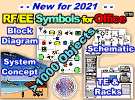 It was a lot of work, but I finally finished
a version of the "RF & Electronics Schematic & Block Diagram Symbols" that
works well with Microsoft Office™ programs Word™, Excel™, and Power Point™.
This is an equivalent of the extensive set of amplifier, mixer, filter, switch,
connector, waveguide, digital, analog, antenna, and other commonly used symbols
for system block diagrams and schematics created for Visio™. Each of the 1,000 or
so symbols was exported individually from Visio in the EMF file format, then imported
into Word on a Drawing Canvas. The EMF format allows an image to be scaled up or
down without becoming pixelated, so all the shapes can be resized in a document
and still look good. The imported symbols can also be UnGrouped into their original
constituent parts for editing. Check them out! It was a lot of work, but I finally finished
a version of the "RF & Electronics Schematic & Block Diagram Symbols" that
works well with Microsoft Office™ programs Word™, Excel™, and Power Point™.
This is an equivalent of the extensive set of amplifier, mixer, filter, switch,
connector, waveguide, digital, analog, antenna, and other commonly used symbols
for system block diagrams and schematics created for Visio™. Each of the 1,000 or
so symbols was exported individually from Visio in the EMF file format, then imported
into Word on a Drawing Canvas. The EMF format allows an image to be scaled up or
down without becoming pixelated, so all the shapes can be resized in a document
and still look good. The imported symbols can also be UnGrouped into their original
constituent parts for editing. Check them out!
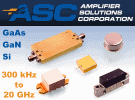 ASC designs and manufactures hybrid, surface
mount flange, open carrier and connectorized amplifiers for low, medium and high
power applications using gallium nitride (GaN), gallium arsenide (GaAs) and silicon
(Si) transistor technologies. ASC's thick film designs operate in the frequency
range of 300 kHz to 6 GHz. ASC offers thin film designs that operate up
to 20 GHz. ASC designs and manufactures hybrid, surface
mount flange, open carrier and connectorized amplifiers for low, medium and high
power applications using gallium nitride (GaN), gallium arsenide (GaAs) and silicon
(Si) transistor technologies. ASC's thick film designs operate in the frequency
range of 300 kHz to 6 GHz. ASC offers thin film designs that operate up
to 20 GHz.
Tuesday the 2nd
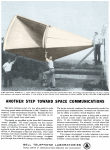 Little did the engineers depicted in this
Bell Telephone Laboratories advertisement in a 1959 issue of Radio-Electronics
magazine know the significance the "Sugar
Scoop Antenna" they were erecting at the time would play in the world of astrophysics.
Their intention, following the recently completed International Geophysical Year
(IGY) efforts, was to design and build a system for characterizing the Earth's atmosphere
in preparation for satellite communications. A cutting-edge, cryogenically-cooled
ruby-based maser amplifier operated in the 5,600 MHz realm with thermal noise
in the 18K region. Undoubtedly lots of good information was gleaned, but the most
notable result from that antenna was the discovery in 1964 of the Cosmic Microwave
Background (CMB) radiation by Bell scientists Drs. Robert W. Wilson and Arno
A. Penzias. The pair was surveying the sky in the microwave spectrum and noticed
that regardless of where the antenna was pointed, there was always a fairly constant
level of "noise" that could not be removed from the system. It occurred to them
that they had stumbled upon the very electromagnetic signature of the early post
Big Bang universe. The rest, as the saying goes, is history... Little did the engineers depicted in this
Bell Telephone Laboratories advertisement in a 1959 issue of Radio-Electronics
magazine know the significance the "Sugar
Scoop Antenna" they were erecting at the time would play in the world of astrophysics.
Their intention, following the recently completed International Geophysical Year
(IGY) efforts, was to design and build a system for characterizing the Earth's atmosphere
in preparation for satellite communications. A cutting-edge, cryogenically-cooled
ruby-based maser amplifier operated in the 5,600 MHz realm with thermal noise
in the 18K region. Undoubtedly lots of good information was gleaned, but the most
notable result from that antenna was the discovery in 1964 of the Cosmic Microwave
Background (CMB) radiation by Bell scientists Drs. Robert W. Wilson and Arno
A. Penzias. The pair was surveying the sky in the microwave spectrum and noticed
that regardless of where the antenna was pointed, there was always a fairly constant
level of "noise" that could not be removed from the system. It occurred to them
that they had stumbled upon the very electromagnetic signature of the early post
Big Bang universe. The rest, as the saying goes, is history...
 The
Wireless Telecom Group,
comprised of Boonton, CommAgility, Holzworth, and Noisecom, is a global designer
and manufacturer of advanced RF and microwave components, modules, systems, and
instruments. Serving the wireless, telecommunication, satellite, military, aerospace,
semiconductor and medical industries, Wireless Telecom Group products enable innovation
across a wide range of traditional and emerging wireless technologies. A unique
set of high-performance products including peak power meters, signal generators,
phase noise analyzers, signal processing modules, 5G and LTE PHY/stack software,
noise sources, and programmable noise generators. The
Wireless Telecom Group,
comprised of Boonton, CommAgility, Holzworth, and Noisecom, is a global designer
and manufacturer of advanced RF and microwave components, modules, systems, and
instruments. Serving the wireless, telecommunication, satellite, military, aerospace,
semiconductor and medical industries, Wireless Telecom Group products enable innovation
across a wide range of traditional and emerging wireless technologies. A unique
set of high-performance products including peak power meters, signal generators,
phase noise analyzers, signal processing modules, 5G and LTE PHY/stack software,
noise sources, and programmable noise generators.
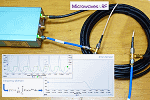 An interesting article entitled "Using
a VNA Like a Time-Domain Reflectometer" is currently posted on the Microwaves &
RF website. Author Roger Denker begins: "While VNA network measurements in
the frequency domain help optimize or verify implementation of devices and components,
time-domain measurements are effective for analyzing network geometry and specific
sections of a network. Time-domain reflectometry (TDR) is a technique that measures
and displays the impedance of a network (cable, filter, and so on) over time. Traditionally,
this is done with a device that generates very fast pulses, injects them on the
network, and measures the time and amplitude of reflected pulses. TDR yields information
about the impedance as a function of the time it takes for a pulse to reflect or
travel through the medium. And, because the signals travel with (nearly) the speed
of light, the time can be translated to a distance through a cable or network..." An interesting article entitled "Using
a VNA Like a Time-Domain Reflectometer" is currently posted on the Microwaves &
RF website. Author Roger Denker begins: "While VNA network measurements in
the frequency domain help optimize or verify implementation of devices and components,
time-domain measurements are effective for analyzing network geometry and specific
sections of a network. Time-domain reflectometry (TDR) is a technique that measures
and displays the impedance of a network (cable, filter, and so on) over time. Traditionally,
this is done with a device that generates very fast pulses, injects them on the
network, and measures the time and amplitude of reflected pulses. TDR yields information
about the impedance as a function of the time it takes for a pulse to reflect or
travel through the medium. And, because the signals travel with (nearly) the speed
of light, the time can be translated to a distance through a cable or network..."
 Michael Maguire proudly shows his
Pickett Model N1010-ES Trig Classroom Demonstrator. He picked it up at a garage
sale for $20 - an fine example of being in the right place at the right time! It
appears to be in excellent condition. The sliding cursor was missing, so he had
one made. The "ES"
(Eye Saver) designation refers to the black markings on a yellow background. Pickett
produced many versions of the N1010 including this "Trig," the "Duplex," the "Trig
Duplex," "Power Trig," the "Transitional," and the "Super Power Trig." There were
pre-Eye Saver models of most of these as well... Michael Maguire proudly shows his
Pickett Model N1010-ES Trig Classroom Demonstrator. He picked it up at a garage
sale for $20 - an fine example of being in the right place at the right time! It
appears to be in excellent condition. The sliding cursor was missing, so he had
one made. The "ES"
(Eye Saver) designation refers to the black markings on a yellow background. Pickett
produced many versions of the N1010 including this "Trig," the "Duplex," the "Trig
Duplex," "Power Trig," the "Transitional," and the "Super Power Trig." There were
pre-Eye Saver models of most of these as well...
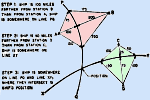 Just as today's generation of engineering
students grew up with and are totally accustomed to and proficient at using computers,
smartphones, positioning devices, CAE software, and various combinations of the
aforementioned, so have the latest cadre of pilots grown up with GPS and electronic
flight charts and planners in the cockpit. The difference is that whereas engineering
students are not still required to learn to use a slide rule and a drafting table
to earn an engineering degree, pilots are still required to learn to navigate using
primitive (not meant derisively) instruments and ground-based navaids to earn a
pilot's license. That's not a bad thing, though, because whereas if your graphing,
2500-function calculator quits working, the only thing at risk is your test score
if you happen to be taking an exam. However, if your electronic navigation fails
while in a limited visibility environment or in controlled airspace, you had better
be able to do some seat-of-the-pants flying or you could be in deep doo-doo. This
1958 article from Popular Electronics magazine presents the newfangled
TACAN (TACtical Air Navigation) and Loran (LOng RAnge Navigation) systems recently
introduced (at the time) by the CAA (Civil Aeronautics Authority), which is now... Just as today's generation of engineering
students grew up with and are totally accustomed to and proficient at using computers,
smartphones, positioning devices, CAE software, and various combinations of the
aforementioned, so have the latest cadre of pilots grown up with GPS and electronic
flight charts and planners in the cockpit. The difference is that whereas engineering
students are not still required to learn to use a slide rule and a drafting table
to earn an engineering degree, pilots are still required to learn to navigate using
primitive (not meant derisively) instruments and ground-based navaids to earn a
pilot's license. That's not a bad thing, though, because whereas if your graphing,
2500-function calculator quits working, the only thing at risk is your test score
if you happen to be taking an exam. However, if your electronic navigation fails
while in a limited visibility environment or in controlled airspace, you had better
be able to do some seat-of-the-pants flying or you could be in deep doo-doo. This
1958 article from Popular Electronics magazine presents the newfangled
TACAN (TACtical Air Navigation) and Loran (LOng RAnge Navigation) systems recently
introduced (at the time) by the CAA (Civil Aeronautics Authority), which is now...
 With more than 1000
custom-built stencils, this has got to be the most comprehensive set of
Visio Stencils available for RF, analog, and digital system and schematic
drawings! Every stencil symbol has been built to fit proportionally on the included
A-, B-, and C-size drawing page templates (or use your own page if preferred). Components
are provided for system block diagrams, conceptual drawings, schematics, test equipment,
racks (EIA 19", ETSI 21"), and more. Test equipment and racks are built at a 1:1
scale so that measurements can be made directly using Visio built-in dimensioning
objects. Page templates are provided with a preset scale (changeable) for a good
presentation that can incorporate all provided symbols... With more than 1000
custom-built stencils, this has got to be the most comprehensive set of
Visio Stencils available for RF, analog, and digital system and schematic
drawings! Every stencil symbol has been built to fit proportionally on the included
A-, B-, and C-size drawing page templates (or use your own page if preferred). Components
are provided for system block diagrams, conceptual drawings, schematics, test equipment,
racks (EIA 19", ETSI 21"), and more. Test equipment and racks are built at a 1:1
scale so that measurements can be made directly using Visio built-in dimensioning
objects. Page templates are provided with a preset scale (changeable) for a good
presentation that can incorporate all provided symbols...
 Aegis Power Systems is a leading supplier
of AC-DC and
DC-DC power supplies for custom and special applications. Aegis has been designing
and building highly reliable custom power supplies since 1995. They offer a complete
line of switch mode power supplies and power converters for a variety of markets
including defense, industrial, aircraft, VME, and telecom. Supports military, aircraft,
EV, telecom, and embedded computing applications. Design and manufacture of custom
power supply solutions to meet each customer's exacting specifications. Please visit
Aegis Power Systems today. Aegis Power Systems is a leading supplier
of AC-DC and
DC-DC power supplies for custom and special applications. Aegis has been designing
and building highly reliable custom power supplies since 1995. They offer a complete
line of switch mode power supplies and power converters for a variety of markets
including defense, industrial, aircraft, VME, and telecom. Supports military, aircraft,
EV, telecom, and embedded computing applications. Design and manufacture of custom
power supply solutions to meet each customer's exacting specifications. Please visit
Aegis Power Systems today.
Monday the 1st
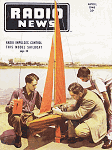 As
you can tell from all the vintage modeling and electronics magazine I own and use
to post various article, I am prone to waxing nostalgic about the days of yore.
Being born in 1958, I am part of the last generation of people brought up at a time
when patriotism, courtesy, manners, and civility was taught in school and in the
public square by fellow citizens and even politicians. However, there are limits
to my desire to enjoy the environment of the good 'ole days, and one of them is
the need to build (often), tune, and repair nearly all the electronic equipment
used in model aviation and model boating activities. This "Radio
Controlled Model Sailboat" article from a 1948 issue of Radio News
magazine is a prime example of what I mean. While knowing how to do all the work
involved in the system created by these two Raytheon engineers is a great achievement,
the work involved is extremely time consuming and takes away significantly from
the time actually spent enjoying sailing the boat. Modern compact, powerful, reliable,
relatively inexpensive, fully proportional, feature-packed radio systems are much
preferred over the former. Here is a short tale of my own venture into R/C sailboating
with a Thunder Tiger Victoria sloop, circa 2000... As
you can tell from all the vintage modeling and electronics magazine I own and use
to post various article, I am prone to waxing nostalgic about the days of yore.
Being born in 1958, I am part of the last generation of people brought up at a time
when patriotism, courtesy, manners, and civility was taught in school and in the
public square by fellow citizens and even politicians. However, there are limits
to my desire to enjoy the environment of the good 'ole days, and one of them is
the need to build (often), tune, and repair nearly all the electronic equipment
used in model aviation and model boating activities. This "Radio
Controlled Model Sailboat" article from a 1948 issue of Radio News
magazine is a prime example of what I mean. While knowing how to do all the work
involved in the system created by these two Raytheon engineers is a great achievement,
the work involved is extremely time consuming and takes away significantly from
the time actually spent enjoying sailing the boat. Modern compact, powerful, reliable,
relatively inexpensive, fully proportional, feature-packed radio systems are much
preferred over the former. Here is a short tale of my own venture into R/C sailboating
with a Thunder Tiger Victoria sloop, circa 2000...
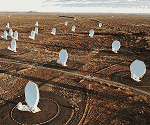 "An international team of researchers has
demonstrated that the
Square Kilometre Array Observatory (SKAO) is capable of detecting radio emissions
from normal spiral galaxies in the early universe. The SKAO, whose construction
began this year, will soon be the largest radio telescope in the world. The astronomers,
who are part of the SKAO's 'Extragalactic Continuum' working group, are looking
for a way to study a cosmic era in which star-forming activity suddenly decreased
after an epoch known as 'Cosmic Noon.' To this end, they simulated the physical
properties of the interstellar medium of galaxies similar to the Triangulum Galaxy
(M 33) and the Whirlpool Galaxy (M 51) in an early age of the Universe. The results
show that potential surveys should be sensitive enough to detect galaxies already
in SKAO's first deployment phase..." "An international team of researchers has
demonstrated that the
Square Kilometre Array Observatory (SKAO) is capable of detecting radio emissions
from normal spiral galaxies in the early universe. The SKAO, whose construction
began this year, will soon be the largest radio telescope in the world. The astronomers,
who are part of the SKAO's 'Extragalactic Continuum' working group, are looking
for a way to study a cosmic era in which star-forming activity suddenly decreased
after an epoch known as 'Cosmic Noon.' To this end, they simulated the physical
properties of the interstellar medium of galaxies similar to the Triangulum Galaxy
(M 33) and the Whirlpool Galaxy (M 51) in an early age of the Universe. The results
show that potential surveys should be sensitive enough to detect galaxies already
in SKAO's first deployment phase..."
 In the early days of television, what we
today refer to as cathode ray tubes were called
kinescopes. The kinescope on the receiving end displayed images generated
by a tube called an iconoscope on the transmission end. Kinescopes had round faces
onto which a rectangular picture was electronically drawn. Once manufacturing technology
evolved sufficiently, it became possible to make them rectangular in order to save
on material and to fit a larger picture in a smaller area. The real story as told
in this 1947 Radio News magazine article from my perspective is appreciating the
ingenuity of the manufacturing engineers for an ability to develop machines that
handle very complex operations. They were wonders of electromechanical manipulation.
There were still some operations that needed human dexterity and decision making.
Oh, and I learned a new word - "lehr"... In the early days of television, what we
today refer to as cathode ray tubes were called
kinescopes. The kinescope on the receiving end displayed images generated
by a tube called an iconoscope on the transmission end. Kinescopes had round faces
onto which a rectangular picture was electronically drawn. Once manufacturing technology
evolved sufficiently, it became possible to make them rectangular in order to save
on material and to fit a larger picture in a smaller area. The real story as told
in this 1947 Radio News magazine article from my perspective is appreciating the
ingenuity of the manufacturing engineers for an ability to develop machines that
handle very complex operations. They were wonders of electromechanical manipulation.
There were still some operations that needed human dexterity and decision making.
Oh, and I learned a new word - "lehr"...
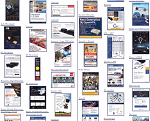 It has been my belief for a long time that
the vast majority of
print magazine advertisements are never seen by potential customers because
very few of those potential customers ever bother to pick up a print magazine. More
than a decade ago (around 2007) when I was spending my last days working in a corporate
environment, I do not ever recall seeing anyone reading a trade magazine, be it
Microwave Journal, Microwaves & RF, Electronic
Design, EE|Times, or any of the others. In fact, most of the magazines
I saw were deposited in the mail room recycle or trash bin before they ever made
it to an engineer's, technician's, or manager's desk. That is not to say or imply
the magazines are not excellent - they are, indeed - but even back then most people
were getting their needed information online. Being able to show a print version
circulation number to advertisers does not in any way correlate directly to the
number of potential customers who will ever see their advertisements... It has been my belief for a long time that
the vast majority of
print magazine advertisements are never seen by potential customers because
very few of those potential customers ever bother to pick up a print magazine. More
than a decade ago (around 2007) when I was spending my last days working in a corporate
environment, I do not ever recall seeing anyone reading a trade magazine, be it
Microwave Journal, Microwaves & RF, Electronic
Design, EE|Times, or any of the others. In fact, most of the magazines
I saw were deposited in the mail room recycle or trash bin before they ever made
it to an engineer's, technician's, or manager's desk. That is not to say or imply
the magazines are not excellent - they are, indeed - but even back then most people
were getting their needed information online. Being able to show a print version
circulation number to advertisers does not in any way correlate directly to the
number of potential customers who will ever see their advertisements...
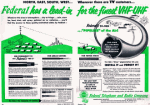 Coaxial cable is the most familiar form
of
RF transmission line for most people these days. Up until 2009 when the U.S.
switched to digital television (DTV), there were still a fairly large number of
people who had the old 300 Ω twin lead cable running from roof-top antennas
to TV sets. Over-the-air reception has petered off precipitously since then. Coaxial
cable is undoubtedly more convenient and forgiving regarding routing since proximity
to structures - particularly metallic components - is less sensitive than twin lead.
Good quality 300 Ω twin lead cable (~70¢/foot today for 100') used to cost
less than good quality 75 Ω RG-6 cable (~35¢/foot today for 100'), but just
a couple decades ago when twin lead dominated, the opposite was true. What has not
changed is the insertion loss of 300 Ω twin lead cable is typically around
2 dB at VHF TV channel frequencies (54-210 MHz), and 450 Ω ladder
line (twin lead on steroids) is about 1/2 or less of that (see "Loss Figures for
300 Ohm Twin Line"). Insertion loss on RG-59 coaxial cable is around 4 dB/100'
in the same band (RG-6 is ~3 dB/100', and RG-11 is ~2 dB/100')... Coaxial cable is the most familiar form
of
RF transmission line for most people these days. Up until 2009 when the U.S.
switched to digital television (DTV), there were still a fairly large number of
people who had the old 300 Ω twin lead cable running from roof-top antennas
to TV sets. Over-the-air reception has petered off precipitously since then. Coaxial
cable is undoubtedly more convenient and forgiving regarding routing since proximity
to structures - particularly metallic components - is less sensitive than twin lead.
Good quality 300 Ω twin lead cable (~70¢/foot today for 100') used to cost
less than good quality 75 Ω RG-6 cable (~35¢/foot today for 100'), but just
a couple decades ago when twin lead dominated, the opposite was true. What has not
changed is the insertion loss of 300 Ω twin lead cable is typically around
2 dB at VHF TV channel frequencies (54-210 MHz), and 450 Ω ladder
line (twin lead on steroids) is about 1/2 or less of that (see "Loss Figures for
300 Ohm Twin Line"). Insertion loss on RG-59 coaxial cable is around 4 dB/100'
in the same band (RG-6 is ~3 dB/100', and RG-11 is ~2 dB/100')...
 RF Cascade Workbook is the next phase in the evolution of
RF Cafe's long-running series, RF Cascade Workbook. Chances are you have
never used a spreadsheet quite like this (click here for screen capture). It is a full-featured RF system
cascade parameter and frequency planner that includes filters and mixers for a mere
$45. Built in MS Excel, using RF Cascade Workbook 2018 is a cinch
and the format is entirely customizable. It is significantly easier and faster than
using a multi-thousand dollar simulator when a high level system analysis is all
that is needed. An intro video takes you through the main features...
RF Cascade Workbook is the next phase in the evolution of
RF Cafe's long-running series, RF Cascade Workbook. Chances are you have
never used a spreadsheet quite like this (click here for screen capture). It is a full-featured RF system
cascade parameter and frequency planner that includes filters and mixers for a mere
$45. Built in MS Excel, using RF Cascade Workbook 2018 is a cinch
and the format is entirely customizable. It is significantly easier and faster than
using a multi-thousand dollar simulator when a high level system analysis is all
that is needed. An intro video takes you through the main features...
 Exodus Advanced Communications is a multinational
RF communication equipment and engineering service company serving both commercial
and government entities and their affiliates worldwide. Power amplifiers ranging
from 10 kHz to 51 GHz with various output power levels and noise figure
ranges, we fully support custom designs and manufacturing requirements for both
small and large volume levels. decades of combined experience in the RF field for
numerous applications including military jamming, communications, radar, EMI/EMC
and various commercial projects with all designing and manufacturing of our HPA,
MPA, and LNA products in-house. Exodus Advanced Communications is a multinational
RF communication equipment and engineering service company serving both commercial
and government entities and their affiliates worldwide. Power amplifiers ranging
from 10 kHz to 51 GHz with various output power levels and noise figure
ranges, we fully support custom designs and manufacturing requirements for both
small and large volume levels. decades of combined experience in the RF field for
numerous applications including military jamming, communications, radar, EMI/EMC
and various commercial projects with all designing and manufacturing of our HPA,
MPA, and LNA products in-house.
These archive pages are provided in order to make it easier for you to find items
that you remember seeing on the RF Cafe homepage. Of course probably the easiest
way to find anything on the website is to use the "Search
RF Cafe" box at the top of every page.
About RF Cafe.
Homepage Archive Pages
2024:
Jan |
Feb |
Mar |
Apr |
May |
Jun |
Jul |
Aug |
Sep |
Oct |
Nov |
Dec
2023:
Jan |
Feb |
Mar |
Apr |
May |
Jun |
Jul |
Aug |
Sep |
Oct |
Nov |
Dec
2022:
Jan |
Feb |
Mar |
Apr |
May |
Jun |
Jul |
Aug |
Sep |
Oct |
Nov |
Dec
2021:
Jan |
Feb |
Mar |
Apr |
May |
Jun |
Jul |
Aug |
Sep |
Oct |
Nov |
Dec
2020:
Jan |
Feb |
Mar |
Apr |
May |
Jun |
Jul |
Aug |
Sep |
Oct |
Nov |
Dec
2019:
Jan |
Feb |
Mar |
Apr |
May |
Jun |
Jul |
Aug |
Sep |
Oct |
Nov |
Dec
2018:
Jan |
Feb |
Mar |
Apr |
May |
Jun |
Jul |
Aug |
Sep |
Oct |
Nov |
Dec
2017:
Jan |
Feb |
Mar |
Apr |
May |
Jun |
Jul |
Aug |
Sep |
Oct |
Nov |
Dec
2016:
Jan |
Feb |
Mar |
Apr |
May |
Jun |
Jul |
Aug |
Sep |
Oct |
Nov |
Dec
2015:
Jan |
Feb |
Mar |
Apr |
May |
Jun |
Jul |
Aug |
Sep |
Oct |
Nov |
Dec
2014:
Jan |
Feb |
Mar |
Apr |
May |
Jun |
Jul |
Aug |
Sep |
Oct |
Nov |
Dec
2013:
Jan |
Feb |
Mar |
Apr |
May |
Jun |
Jul |
Aug |
Sep |
Oct |
Nov |
Dec
2012:
1 |
2 |
3 |
4 |
5 |
6 |
7 |
8 |
9 |
10 |
11 |
12 |
13 (no archives before 2012)
|










 RF Superstore
RF Superstore


 Atek
Midas
Atek
Midas Antenna radiation (beam) patterns
Antenna radiation (beam) patterns






 Berkeley Nucleonics Corporation (BNC)
Berkeley Nucleonics Corporation (BNC)

















 Exodus Advanced Communications
Exodus Advanced Communications